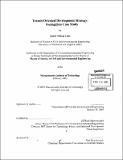Transit oriented development strategy : Guangzhou case study
Author(s)
Lion, Satish McKay, 1978-
DownloadFull printable version (15.18Mb)
Other Contributors
Massachusetts Institute of Technology. Dept. of Civil and Environmental Engineering.
Advisor
Fred Moavenzadeh.
Terms of use
Metadata
Show full item recordAbstract
Mega-cities are the centers of population, economy, culture and political power. Yet, along with these characteristics, they are also the greatest source of energy consumption, resource depletion, and pollution. In order for developing countries to take a more sustainable development path, they must address their growing demand for energy and strive to find solutions to reduce their demand and increase their efficiency. Mega-cities stand out as natural targets for such solutions given their extreme population and waste generation. Specifically, urban sprawl is a major source of energy inefficiency. Not only does it lead to more vehicle miles travels, more fuel consumption, more air pollution, but also to inefficiencies in infrastructure provision. De-densification of residential and commercial districts causes an increase in both energy services and materials. Transit Oriented Development (TOD) is an effective method of fighting the negative impacts of urban sprawl, by reshaping the travel and land-use patterns into a more sustainable form. To achieve the full potential of a TOD it is critical to have long-term strategic planning, and cross-jurisdictional, complementary, and comprehensive policies and institutions. To effectively reduce energy consumption through TOD the policies must span multiple jurisdictions and cover the areas of transportation, urban planning, and land-use. These policies must be aimed at reducing vehicle miles traveled while blustering transit ridership.
Description
Thesis (S.M.)--Massachusetts Institute of Technology, Dept. of Civil and Environmental Engineering, 2003. Includes bibliographical references (leaves 101-104).
Date issued
2003Department
Massachusetts Institute of Technology. Department of Civil and Environmental EngineeringPublisher
Massachusetts Institute of Technology
Keywords
Civil and Environmental Engineering.